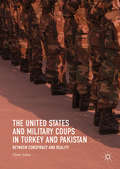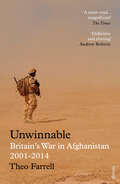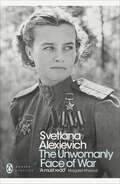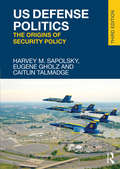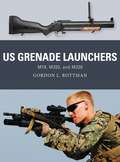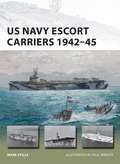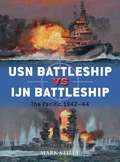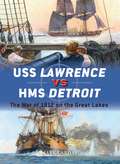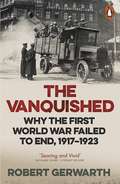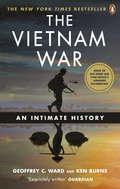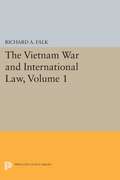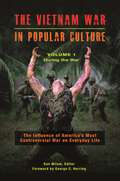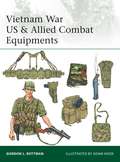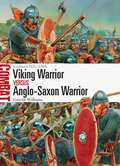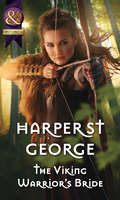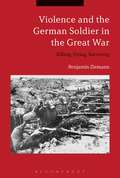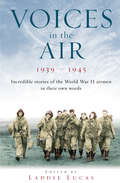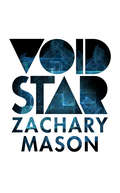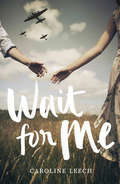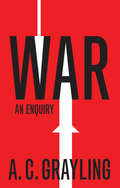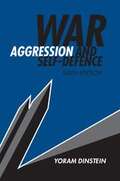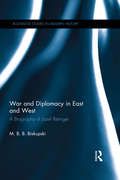- Table View
- List View
The United States and Military Coups in Turkey and Pakistan: Between Conspiracy and Reality (PDF)
by Ömer AslanThis comparative study explores the involvement of the United States in four successful military coups in Turkey and Pakistan during the Cold War. Focusing on military-to-military relations with the US in each country, the book offers insight into how external actors can impact the outcomes of coups, particularly through socialization via military training, education, and international organizations such as NATO. Drawing upon recently declassified government documents and a trove of unexplored interviews with high-ranking officials, Ömer Aslan also examines how coup plotters in both countries approached the issue of US reaction before, during, and after their coups. As armed forces have continued to make and unmake Turkish and Pakistani governments well into the twenty-first century, this volume offers original, probing analysis of the circumstances which make coups possible.
Unwinnable: Britain’s War in Afghanistan, 2001–2014 (Everyman's Library CLASSICS)
by Theo FarrellChosen as a Book of the Year by the Sunday Times and the Evening Standard'Authoritative and provocative… For its range and breadth, it is a tour de force and a must read' Evening StandardIt could have been a very different story.British and US forces could have successfully withdrawn from Afghanistan in 2002, having done the job they set out to do: to defeat al-Qaeda and stop it from launching further terrorist attacks against the West. Instead, British troops became part of a larger international effort to stabilise the country. Yet over the following thirteen years the British military paid a heavy price for their presence in Helmand province; and when Western troops departed from Afghanistan in 2014, they had failed to stop a Taliban resurgence. In this magisterial study, Theo Farrell explains the origins and causes of the war, providing fascinating insight into the British government’s reaction to 9/11 and the steps that led the British Army to Helmand. He details the specific campaigns and missions over the subsequent years, revealing how the military’s efforts to create a strategy for success were continually undermined by political realities in Kabul and back home. And he demonstrates conclusively that the West's failure to understand the dynamics of local conflict in the country, and to tackle Afghan government corruption, meant that the war was unwinnable.Drawing on unprecedented access to military reports and government documents, as well as hundreds of interviews with Western commanders, senior figures in the Taliban, Afghan civilians and British politicians, Unwinnable is an extraordinary work of scholarship. Its depth of analysis, scope and authority make it the definitive history of Britain’s War in Afghanistan.
The Unwomanly Face of War: An Oral History Of Women In World War Ii (Penguin Modern Classics)
by Larissa Volokhonsky Richard Pevear Svetlana AlexievichThe long-awaited translation of the classic oral history of Soviet women's experiences in the Second World War - from the winner of the Nobel Prize in LiteratureBringing together dozens of voices in her distinctive style, The Unwomanly Face of War is Svetlana Alexievich's collection of stories from Soviet women who lived through the Second World War: on the front lines, on the home front, and in occupied territories. As Alexievich gives voice to women who are absent from official narratives - captains, sergeants, nurses, snipers, pilots - she shows us a new version of the war we're so familiar with, creating an extraordinary alternative history from their private stories.Published in 1985 in Russia and now available in English for the first time, The Unwomanly Face of War was Alexievich's first book and a huge bestseller in the Soviet Union, establishing her as a brilliantly revolutionary writer.
US Defense Politics: The Origins of Security Policy
by Harvey M. Sapolsky Eugene Gholz Caitlin TalmadgeThis book provides an accessible overview of US defense politics for upper-level students. This new edition has been fully updated and revised, with a new chapter on veterans and new material on topics such as cyberwarfare and lobbying. Analyzing the ways in which the United States prepares for war, the authors demonstrate how political and organizational interests determine US defense policy and warn against over-emphasis on planning, centralization, and technocracy. Emphasizing the process of defense policy-making rather than just the outcomes of that process, US Defense Politics departs from the traditional style of many other textbooks. Designed to help students understand the practical side of American national security policy, the book examines the following key themes: US grand strategy; who joins America's military; how and why weapons are bought; the management of defense; public attitudes toward the military and casualties; the roles of the president and the Congress in controlling the military; the effects of 9/11 and the Global War on Terror on security policy, homeland security, government reorganizations, and intra- and inter-service relations. The third edition will be essential reading for students of US defense politics, national security policy, and homeland security, and highly recommended for students of US foreign policy, public policy, and public administration.
US Defense Politics: The Origins of Security Policy
by Harvey M. Sapolsky Eugene Gholz Caitlin TalmadgeThis book provides an accessible overview of US defense politics for upper-level students. This new edition has been fully updated and revised, with a new chapter on veterans and new material on topics such as cyberwarfare and lobbying. Analyzing the ways in which the United States prepares for war, the authors demonstrate how political and organizational interests determine US defense policy and warn against over-emphasis on planning, centralization, and technocracy. Emphasizing the process of defense policy-making rather than just the outcomes of that process, US Defense Politics departs from the traditional style of many other textbooks. Designed to help students understand the practical side of American national security policy, the book examines the following key themes: US grand strategy; who joins America's military; how and why weapons are bought; the management of defense; public attitudes toward the military and casualties; the roles of the president and the Congress in controlling the military; the effects of 9/11 and the Global War on Terror on security policy, homeland security, government reorganizations, and intra- and inter-service relations. The third edition will be essential reading for students of US defense politics, national security policy, and homeland security, and highly recommended for students of US foreign policy, public policy, and public administration.
US Grenade Launchers: M79, M203, and M320 (Weapon)
by Gordon L. Rottman Johnny Shumate Alan GillilandIn an effort to provide the US infantryman with more firepower to cover the range gap between the hand grenade and the light mortar, the 40mm M79 grenade launcher – a shoulder-fired, single-shot weapon – entered service with US forces in 1961.Reliable, easy to use, and lethally effective, the M79 soon became an iconic symbol of the Vietnam War and had a profound influence on small-unit tactics. As the Vietnam conflict continued, it was joined on the front line by experimental models such as the magazine-fed T148E1, as well as two launchers intended to be fitted under the barrel of the new M16 assault rifle: Colt's XM148 and AAI Corporation's M203. The M203 remains in US Army service today, while the US Marine Corps now also fields the M32 multiple grenade launcher – like the M79, a standalone weapon. Featuring full-colour artwork, this is the story of the rugged and formidable grenade launchers that equipped the United States and its allies in Vietnam and beyond from the 1960s to the present day.
US Navy Escort Carriers 1942–45 (New Vanguard #251)
by Mark Stille Mr Paul WrightWhile not as famous as their larger and faster sister ships such as the Essex- and Yorktown-class carriers, escort carriers made an enormous contribution towards Allied victory both in the Pacific and Atlantic theatres. Rather than relying on size or speed, it was their sheer numbers that made them so effective. Indeed, the Casablanca-class escort carrier was the most-produced aircraft carrier in history. In partnership with the Royal Navy, they provided the backbone of Allied anti-submarine efforts in the Atlantic, finally and irrevocably turning the tide of the war against the U-boats in 1943. In the Pacific, they provided the air cover for the series of landings which led to the doorstep of Japan by 1945. These robust ships faced submarine, air, and even surface threats from the Japanese, but proved able to contend with everything thrown their way.Fully illustrated with contemporary photographs and unique specially commissioned artwork, this book shines a new light on these unjustly overlooked workhorses of the US Navy – ships that helped usher in the Allied victory over the Axis powers in the Atlantic and Pacific.
USN Battleship vs IJN Battleship: The Pacific 1942–44 (Duel #83)
by Paul Wright Mark Stille Alan GillilandIn the build-up to World War II both the United States and Japan believed their battleships would play a central role in battle, but after the Pacific War began in December 1941, the role of the battleship proved to be much more limited than either side expected. There would be only two battleship vs battleship actions in the Pacific in World War II, both of which are assessed in this engaging study. At Guadalcanal in 1942, Kirishima faced two modern US battleships, USS Washington and USS South Dakota. In the Surigao Strait in 1944, two World War I-era Japanese battleships, Yamashiro and Fuso, faced six American battleships supported by four heavy cruisers in history's last-ever clash between battleships.Employing full-colour artwork, carefully selected archive photographs, and expert analysis, former US Navy Commander Mark E. Stille examines the two head-to-head clashes between the battleships deployed by the United States and Japan in the struggle for control of the Pacific during World War II.
USS Lawrence vs HMS Detroit: The War of 1812 on the Great Lakes (Duel)
by Mark Lardas Mr Paul WrightThe most critical naval fighting during the War of 1812 took place, not on the high seas, but on the inland lakes of North America: the Great Lakes and Lake Champlain. Carrying between 12 and 22 cannon, the British and American sloops-of-war were ship-rigged, brig-rigged or schooner-rigged vessels. Lakes actions often involved two ships facing each other broadside to broadside, the best example of which was the battle of Lake Erie in 1813 where HMS Detroit led a Royal Navy squadron against the USS Lawrence-led US Navy.Featuring full-colour artwork, this lively study investigates the prolonged struggle between British and US sloops-of-war, highlighting the differences between the war on the lakes and the war on the oceans during the Age of Fighting Sail. It reveals the circumstances under which these ships were built, how they were armed, and the human story behind their construction and use in battle.
The Vanquished: Why the First World War Failed to End, 1917-1923
by Robert Gerwarth'This war is not the end but the beginning of violence. It is the forge in which the world will be hammered into new borders and new communities. New molds want to be filled with blood, and power will be wielded with a hard fist.' Ernst Jünger (1918)For the Western allies 11 November 1918 has always been a solemn date - the end of fighting which had destroyed a generation, and also a vindication of a terrible sacrifice with the total collapse of their principal enemies: the German Empire, Austria-Hungary and the Ottoman Empire. But for much of the rest of Europe this was a day with no meaning, as a continuing, nightmarish series of conflicts engulfed country after country. In this highly original, gripping book Robert Gerwarth asks us to think again about the true legacy of the First World War. In large part it was not the fighting on the Western front which proved so ruinous to Europe's future, but the devastating aftermath, as countries on both sides of the original conflict were wrecked by revolution, pogroms, mass expulsions and further major military clashes. If the War itself had in most places been a struggle purely between state-backed soldiers, these new conflicts were mainly about civilians and paramilitaries, and millions of people died across central, eastern, and south-eastern Europe before the USSR and a series of rickety and exhausted small new states came into being. Everywhere there were vengeful people, their lives racked by a murderous sense of injustice, and looking for the opportunity to take retribution against enemies real and imaginary. Only a decade later, the rise of the Third Reich and other totalitarian states provided them with the opportunity they had been looking for.
The Vietnam War: An Intimate History
by Geoffrey C. Ward Ken BurnsThis definitive account is perfect for any history-buff this Father’s day.**The New York Times Bestseller****The book of the landmark documentary, The Vietnam War, by Ken Burns and Lynn Novick**The definitive work on the Vietnam War, the conflict that came to define a generation, told from all sides by those who were there.More than forty years after the Vietnam War ended, its legacy continues to fascinate, horrify and inform us. As the first war to be fought in front of TV cameras and beamed around the world, it has been immortalised on film and on the page, and forever changed the way we think about war.Drawing on hundreds of brand new interviews, Ken Burns and Geoffrey C. Ward have created the definitive work on Vietnam. It is the first book to show us the war from every perspective: from idealistic US Marines and the families they left behind to the Vietnamese civilians, both North and South, whose homeland was changed for ever; politicians, POWs and anti-war protesters; and the photographers and journalists who risked their lives to tell the truth. The book sends us into the grit and chaos of combat, while also expertly outlining the complex chain of political events that led America to Vietnam.Beautifully written, this essential work tells the full story without taking sides and reminds us that there is no single truth in war. It is set to redefine our understanding of a brutal conflict, to launch provocative new debates and to shed fresh light on the price paid in ‘blood and bone’ by Vietnamese and Americans alike.
The Vietnam War and International Law, Volume 1
by Richard A. FalkInternational lawyers and distinguished scholars consider the question: Is it legally justifiable to treat the Vietnam War as a civil war or as a peculiar modern species of international law?Originally published in 1968.The Princeton Legacy Library uses the latest print-on-demand technology to again make available previously out-of-print books from the distinguished backlist of Princeton University Press. These editions preserve the original texts of these important books while presenting them in durable paperback and hardcover editions. The goal of the Princeton Legacy Library is to vastly increase access to the rich scholarly heritage found in the thousands of books published by Princeton University Press since its founding in 1905.
The Vietnam War in Popular Culture [2 volumes]: The Influence of America's Most Controversial War on Everyday Life [2 volumes]
by Editor Ron MilamCovering many aspects of the Vietnam War that have not been addressed before, this book supplies new perspectives from academics as well as Vietnam veterans that explore how this key conflict of the 20th century has influenced everyday life and popular culture during the war as well as for the past 50 years.How did the experience of the Vietnam War change the United States, not just in the 1950s through the 1970s, but through to today? What role do popular music and movies play in how we think of the Vietnam War? How similar are the recent wars in Iraq and Afghanistan—and now Syria—to the Vietnam War in terms of duration, cost, success and failure rates, and veteran issues? This two-volume set addresses these questions and many more, examining how the Vietnam War has been represented in media, music, and film, and how American popular culture changed because of the war.Accessibly written and appropriate for students and general readers, this work documents how the war that occurred on the other side of the globe in the jungles of Vietnam impacted everyday life in the United States and influenced various entertainment modes. It not only covers the impact of the counterculture revolution, popular music about Vietnam recorded while the war was being fought (and after), and films made immediately following the end of the war in the 1970s, but also draws connections to more modern events and popular culture expressions, such as films made in the aftermath of September 11, 2001. Attention is paid to the impact of social movements like the environmental movement and the civil rights movement and their relationships to the Vietnam War. The set will also highlight how the experiences and events of the Vietnam War are still impacting current generations through television shows such as Mad Men.
Vietnam War US & Allied Combat Equipments (Elite)
by Adam Hook Gordon L. RottmanOver the eight years of the Vietnam War, US forces used three major types of equipment sets, with numerous modifications for particular circumstances. Different equipments were also used by Special Forces, the South Vietnamese, and other allied ground troops.Vietnam War US & Allied Combat Equipments offers a comprehensive examination of the gear that US and allied soldiers had strapped around their bodies, what they contained, and what those items were used for. Fully illustrated with photographs and artwork detailing how each piece of equipment was used and written by a Special Forces veteran of the conflict, this book will fascinate enthusiasts of military equipment and will be an ideal reference guide for re-enactors, modellers and collectors of Vietnam War memorabilia.
Viking Warrior vs Anglo-Saxon Warrior: England 865–1066 (Combat #27)
by Peter Dennis Gareth WilliamsIn the two centuries before the Norman invasion of England, Anglo-Saxon and Viking forces clashed repeatedly in bloody battles across the country. Repeated Viking victories in the 9th century led to their settlement in the north of the country, but the tide of war ebbed and flowed until the final Anglo-Saxon victory before the Norman Conquest. Using stunning artwork, this book examines in detail three battles between the two deadly foes: Ashdown in 871 which involved the future Alfred the Great; Maldon in 991 where an Anglo-Saxon army sought to counter a renewed Viking threat; and Stamford Bridge in 1066, in which King Harold Godwinesson abandoned his preparations to repel the expected Norman invasion in order to fight off Harald Hard-Counsel of Norway.Drawing upon historical accounts from both English and Scandinavian sources and from archaeological evidence, Gareth Williams presents a detailed comparison of the weaponry, tactics, strategies and underlying military organization of the Anglo-Saxons and Vikings, and considers the developments which took place on both sides in the two centuries of Viking incursions into Anglo-Saxon England.
The Viking Warrior's Bride: Western Christmas Brides His Mistletoe Wager The Viking Warrior's Bride (Viking Warriors #4)
by Harper St. GeorgeA battle for power and passion
Violence and the German Soldier in the Great War: Killing, Dying, Surviving
by Benjamin ZiemannTranslated into English as the Winner of the Geisteswissenschaften International Translation Prize for Work in the Humanities and Social Sciences 2015.During the Great War, mass killing took place on an unprecedented scale. Violence and the German Soldier in the Great War explores the practice of violence in the German army and demonstrates how he killing of enemy troops, the deaths of German soldiers and their survival were entwined. As the war reached its climax in 1918, German soldiers refused to continue killing in their droves, and thus made an active contribution to the German defeat and ensuing revolution. Examining the postwar period, the chapters of this book also discuss the contested issue of a 'brutalization' of German society as a prerequisite of the Nazi mass movement. Biographical case studies on key figures such as Ernst Jünger demonstrate how the killing of enemy troops by German soldiers followed a complex set of rules. Benjamin Ziemann makes a wealth of extensive archival work available to an Anglophone audience for the first time, enhancing our understanding of the German army and its practices of violence during the First World War as well as the implications of this brutalization in post-war Germany. This book provides new insights into a crucial topic for students of twentieth-century German history and the First World War.
Violence and the German Soldier in the Great War: Killing, Dying, Surviving
by Benjamin ZiemannTranslated into English as the Winner of the Geisteswissenschaften International Translation Prize for Work in the Humanities and Social Sciences 2015.During the Great War, mass killing took place on an unprecedented scale. Violence and the German Soldier in the Great War explores the practice of violence in the German army and demonstrates how he killing of enemy troops, the deaths of German soldiers and their survival were entwined. As the war reached its climax in 1918, German soldiers refused to continue killing in their droves, and thus made an active contribution to the German defeat and ensuing revolution. Examining the postwar period, the chapters of this book also discuss the contested issue of a 'brutalization' of German society as a prerequisite of the Nazi mass movement. Biographical case studies on key figures such as Ernst Jünger demonstrate how the killing of enemy troops by German soldiers followed a complex set of rules. Benjamin Ziemann makes a wealth of extensive archival work available to an Anglophone audience for the first time, enhancing our understanding of the German army and its practices of violence during the First World War as well as the implications of this brutalization in post-war Germany. This book provides new insights into a crucial topic for students of twentieth-century German history and the First World War.
Voices In The Air 1939-1945: Incredible Stories Of The World War Ii Airmen In Their Own Words
by Laddie LucasA unique and enthralling anthology compiled by WWII flying ace, Laddie Lucas, Voices in the Air tells the story of the air battles of the Second World War in the voices of those who took part. Drawn largely on the writings of the combatants themselves from all sides of the conflict, this book offers a vivid and highly individual account of the great aerial campaigns of WWII. From a thrilling account of the first sustained dogfight between Spitfire and Messerschmitt in 1940, to an eighteen-year-old Japanese suicide pilot's last letter home and the Luftwaffe leaders' analysis of 'what went wrong' after the Battle of Britain, the book dramatically deals with every aspect of the war. Full of stories of astonishing escapades, incredible bravery, dogged persistence and moving feats of arms, Voices in the Air honours both the sung and the unsung heroes of the war.
Void Star: A Novel
by Zachary MasonNot far in the future the seas have risen and the central latitudes are emptying but it’s still a good time to be rich in San Francisco where weapons drones patrol the skies to keep out the multitudinous poor. Irina isn’t rich, not quite, but she does have an artificial memory that gives her perfect recall, and lets her act as a medium between her various employers and their AIs, which are complex to the point of opacity. It’s a good gig, paying enough for the annual visits to the Mayo Clinic that keep her from ageing.Kern has no such access; he's one of the many refugees in the sprawling drone-built favelas on the city’s periphery, where he lives like a monk, training relentlessly in martial arts, scraping by as a thief and an enforcer. Thales is from a different world entirely – the mathematically-inclined scion of a Brazilian political clan, he's fled to L.A. after the attack that left him crippled and his father dead. A ragged stranger accosts Thales and demands to know how much he can remember. Kern flees for his life after robbing the wrong mark. Irina finds a secret in the reflection of a laptop’s screen in her employer’s eyeglasses. None are safe as they’re pushed together by subtle forces that stay just out of sight.Vivid, tumultuous and propulsive, Void Star is Zachary Mason’s mind-bending follow-up to his bestselling debut The Lost Books of the Odyssey.
Wait for Me
by Caroline LeechCan their love survive a war? A breathtaking WW2 romance for fans of CODE NAME VERITY and BETWEEN SHADES OF GREY.
War: An Enquiry (Vices And Virtues Ser.)
by A. C. GraylingA renowned philosopher challenges long-held views on just wars, ethical conduct during war, why wars occur, how they alter people and societies, and more For residents of the twenty-first century, a vision of a future without warfare is almost inconceivable. Though wars are terrible and destructive, they also seem unavoidable. In this original and deeply considered book, A. C. Grayling examines, tests, and challenges the concept of war. He proposes that a deeper, more accurate understanding of war may enable us to reduce its frequency, mitigate its horrors, and lessen the burden of its consequences. Grayling explores the long, tragic history of war and how warfare has changed in response to technological advances. He probes much-debated theories concerning the causes of war and considers positive changes that may result from war. How might these results be achieved without violence? In a profoundly wise conclusion, the author envisions “just war theory” in new moral terms, taking into account the lessons of World War II and the Holocaust and laying down ethical principles for going to war and for conduct during war.
War, Aggression And Self-defence
by Yoram DinsteinWar, Aggression and Self-Defence is an indispensable guide to international legal issues of war and peace, the crime of aggression, self-defence and its trigger, armed attack, and the different modalities of self-defence, as well as enforcement measures taken under the aegis of a binding decision of the Security Council. This new and fully updated 6th edition focuses on the key issues at the forefront of the contemporary international legal debate, as well as analysing the new armed conflicts in Syria, Ukraine and Georgia, re-examining the Kampala amendments on the crime of aggression and considering the phenomenon of 'robust' mandates of a peacekeeping force. Suitable for graduate and advanced undergraduate students, this market-leading book offers a wide-ranging and highly readable introduction to the legal issues surrounding war and self-defence.
War and Diplomacy in East and West: A Biography of Józef Retinger (Routledge Studies in Modern History)
by M. B. BiskupskiThe New York Times said of Józef Hieronim Retinger that he was on intimate terms with most leading statesmen of the Western World, including presidents of the United States. He has been repeatedly acknowledged as one of the principle architects of the movement for European unity after the World War II, and one of the outstanding creative political influences of the post war period. He has also been credited with being the dark master behind the so-called "Bilderberg Group," described variously as an organization of idealistic internationalists, and a malevolent global conspiracy. Before that, Retinger involved himself in intelligence activities during World War II and, given the covert and semi-covert nature of many of his activities, it is little wonder that no biography has appeared about him. This book draws on a broad range of international archives to rectify that.
War and Diplomacy in East and West: A Biography of Józef Retinger (Routledge Studies in Modern History)
by M. B. BiskupskiThe New York Times said of Józef Hieronim Retinger that he was on intimate terms with most leading statesmen of the Western World, including presidents of the United States. He has been repeatedly acknowledged as one of the principle architects of the movement for European unity after the World War II, and one of the outstanding creative political influences of the post war period. He has also been credited with being the dark master behind the so-called "Bilderberg Group," described variously as an organization of idealistic internationalists, and a malevolent global conspiracy. Before that, Retinger involved himself in intelligence activities during World War II and, given the covert and semi-covert nature of many of his activities, it is little wonder that no biography has appeared about him. This book draws on a broad range of international archives to rectify that.
